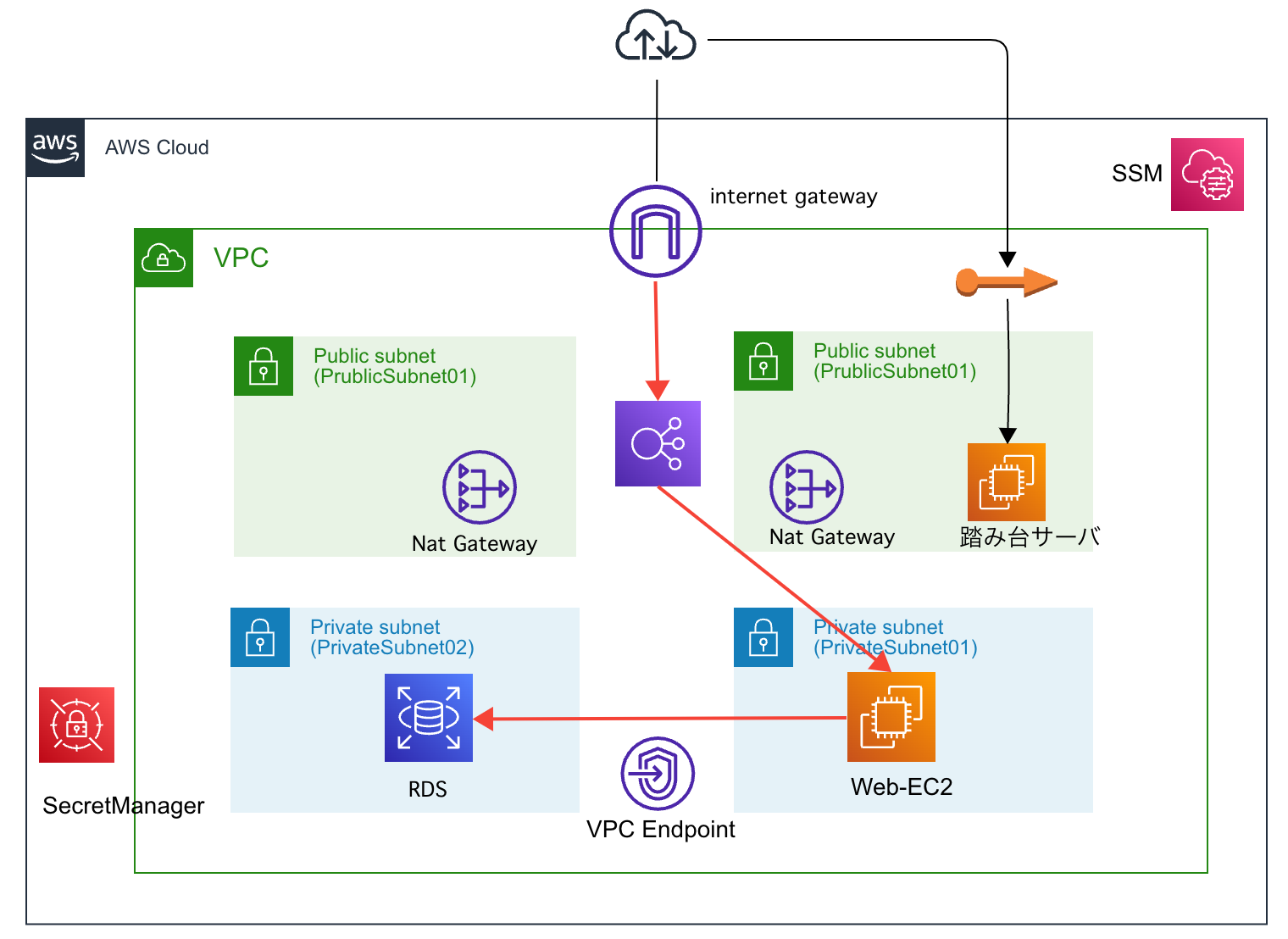はじめに
AWS CDKのキャッチアップがてら、基本的なWeb3層アーキテクチャをaws-cdkで実装してみました。
備忘がてら記録に残します!
ここでは、CDKの基本的な事項についての説明は避けます。
CDKに初めて触れる人にとっては、以下の記事がよくまとまっているのでおすすめです。
開発環境
IDEはVSCodeで、これなしではもう生きていけないGithub Copilotをゴリゴリ使用して実装していきました。
- CDK : 2.72.1 (build ddbfac7)
- TypeScript : typescript@4.9.5
- Github copilot
構成図
【ざっくり要件】
- 踏み台サーバーを設置(SSHとSGの設定練習)
- Web-EC2へはSSMを使用してログイン
- RDSのuser, passwordはsecret managerに登録
-
EC2→RDSへのアクセスにはVPC Interface Endpointを使用- EC2→インターネットへの疎通確認
- EC2→MySQL for RDSへの疎通確認
- 上記ができればOKとする
手順
cdk init
mkdir ec2-cdk && cd ec2-cdk
cdk init app --language typescript
# 使用するlibのinstallは各自必要なものを行ってください
# ↓のような形式で複数指定
npm i @aws-cdk/aws-ec2 @aws-cdk/aws-iam
完成したStack
先に完成物を載せます。
githubのリポジトリにも上がっているのでご参照ください。
【githubリポジトリ】
https://github.com/parupappa/web-app-cdk-stack.git
import * as cdk from '@aws-cdk/core';
import * as ec2 from "@aws-cdk/aws-ec2"; // Allows working with EC2 and VPC resources
import * as iam from "@aws-cdk/aws-iam"; // Allows working with IAM resources
import * as rds from "@aws-cdk/aws-rds"; // Allows working with RDS resources
import * as elbv2 from "@aws-cdk/aws-elasticloadbalancingv2"; // Allows working with ALB resources
import * as elbv2tg from "@aws-cdk/aws-elasticloadbalancingv2-targets"; // Allows working with ALB target groups
export class Ec2CdkStack extends cdk.Stack {
constructor(scope: cdk.Construct, id: string, props?: cdk.StackProps) {
super(scope, id, props);
// VPC
const vpc = new ec2.Vpc(this, "Web-VPC", {
cidr: "10.0.0.0/16",
});
// VPC Endpoint
new ec2.InterfaceVpcEndpoint(this, "ssm_endpoint", {
vpc: vpc,
service: new ec2.InterfaceVpcEndpointAwsService("ssm")
});
new ec2.InterfaceVpcEndpoint(this, "ssmmessage_endpoint", {
vpc: vpc,
service: new ec2.InterfaceVpcEndpointAwsService("ssmmessages")
});
// Create a key pair to be used with this EC2 Instance
const key = new ec2.CfnKeyPair(this, "CfnKeyPair", {
keyName: 'ec2-key-pair',
});
// Delete the key pair when the stack is deleted
key.applyRemovalPolicy(cdk.RemovalPolicy.DESTROY);
// Output the command to get the private key
new cdk.CfnOutput(this, 'GetSSHKeyCommand', {
value: `aws ssm get-parameter --name /ec2/keypair/${key.getAtt('KeyPairId')} --region ${this.region} --with-decryption --query Parameter.Value --output text`,
})
// Security group for the EC2 instance
const securityGroup = new ec2.SecurityGroup(this, "SecurityGroup", {
vpc,
description: "Allow SSH (TCP port 22) and HTTP (TCP port 80) in",
allowAllOutbound: true,
});
// Allow SSH access on port tcp/22
securityGroup.addIngressRule(ec2.Peer.anyIpv4(), ec2.Port.tcp(22), "Allow SSH Access");
// Allow HTTP access on port tcp/80
securityGroup.addIngressRule(ec2.Peer.anyIpv4(), ec2.Port.tcp(80), "Allow HTTP Access");
// IAM role to allow access to other AWS services
const role = new iam.Role(this, "ec2Role", { assumedBy: new iam.ServicePrincipal("ec2.amazonaws.com"), });
// IAM policy attachment to allow access to
role.addManagedPolicy( iam.ManagedPolicy.fromAwsManagedPolicyName("AmazonSSMManagedInstanceCore"));
// Look up the AMI Id for the Amazon Linux 2 Image with CPU Type X86_64
const ami = new ec2.AmazonLinuxImage({
generation: ec2.AmazonLinuxGeneration.AMAZON_LINUX_2,
cpuType: ec2.AmazonLinuxCpuType.X86_64,
});
// Create the EC2 instance using the Security Group, AMI, and KeyPair defined.
const bation_ec2 = new ec2.Instance(this, "BationEC2", {
vpc,
vpcSubnets: { subnetType: ec2.SubnetType.PUBLIC },
instanceType: ec2.InstanceType.of(
ec2.InstanceClass.T2,
ec2.InstanceSize.MICRO
),
machineImage: ami,
securityGroup: securityGroup,
keyName: key.keyName,
role: role,
});
// Elasitc IP for the EC2 instance
const eip = new ec2.CfnEIP(this, "EIP")
// Attach the Elastic IP to the EC2 instance
new ec2.CfnEIPAssociation(this, "EIPAssociation", {
allocationId: eip.attrAllocationId,
instanceId: bation_ec2.instanceId,
});
//////////////////////////////////////////////////////////////////
// ALB to EC2 to RDS Connection
//////////////////////////////////////////////////////////////////
// set instance profile to use ssm
const instanceProfile = new iam.Role(this, "ec2_profile", {
assumedBy: new iam.ServicePrincipal("ec2.amazonaws.com"),
description: "for instance profile",
managedPolicies: [
iam.ManagedPolicy.fromAwsManagedPolicyName("CloudWatchAgentServerPolicy"),
iam.ManagedPolicy.fromAwsManagedPolicyName("AmazonSSMManagedInstanceCore"),
],
});
// create EC2 instance
const web_ec2 = new ec2.Instance(this, "Web-EC2", {
vpc: vpc,
vpcSubnets: { subnetType: ec2.SubnetType.PRIVATE_WITH_NAT },
instanceType: ec2.InstanceType.of(
ec2.InstanceClass.T2,
ec2.InstanceSize.MICRO
),
machineImage: ami,
keyName: key.keyName,
role: instanceProfile,
});
// create RDS instance
const rdsInstance = new rds.DatabaseInstance(this, "RDS", {
engine: rds.DatabaseInstanceEngine.mysql({ version: rds.MysqlEngineVersion.VER_8_0_28, }),
vpc: vpc,
// rds instance type
instanceType: ec2.InstanceType.of(ec2.InstanceClass.T2, ec2.InstanceSize.MICRO),
});
// create ALB
const alb = new elbv2.ApplicationLoadBalancer(this, "ALB", {
vpc: vpc,
internetFacing: true,
});
// listener rule
const listener = alb.addListener("listener", { port: 80 });
listener.addTargets('target', {
port: 80,
targets: [new elbv2tg.InstanceIdTarget(web_ec2.instanceId)],
healthCheck: { path: "/index.html" }
});
// Define Connections
web_ec2.connections.allowFrom(alb, ec2.Port.tcp(80));
rdsInstance.connections.allowFrom(web_ec2, ec2.Port.tcp(3306));
}
}
基本的にはL2コンストラクタを使用しました。
L2コンストラクタで記述すると、必要なリソースをcdkが自動的に判断してくれるので、コードの記述量が大幅に削減できます。
もちろん、細かい指定も可能なので、API Referenceを参照して設定を追加していきます。
cdk deploy
# tsをjsにビルド
cdk build
# または
# ファイルの変更を監視し、自動的に再コンパイル。別ターミナルで常時実行。
npm run watch
# CFnテンプレートを作成
cdk synth
# デプロイ前のセットをいろいろ展開
cdk bootstrap
# deploy
cdk deploy
感想
AWS基礎コンポーネントをcdkを使用することでIaCとして管理できるだけでなく、展開の速さも感じることができました。
(Github Copilotが優秀すぎることもあり)
cdkを実運用に載せるには、チーム内で検討すべき事項がたくさんあると思います。
- CI/CDにどう載せるか
- コーディング規約どうするか
- App > Stack > Constructをどのように定義するか
- etc...
そういった部分を考えるのもSREとしての楽しさ・やりがいなのではないかと思っています。
どこかで自分の理解を深める意味でも体系的にまとめたい...
実装していて一番感じことは、なによりcdkが楽しい!!
参考
